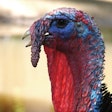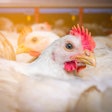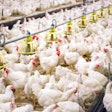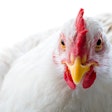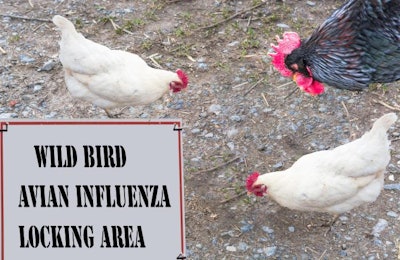
Right now, avian influenza is the highest priority for South Africa’s poultry sector, according to the South African Poultry Association (SAPA).
Since HPAI was first detected in the province of Gauteng in April, the whole industry has been focusing on containing the infection, it says.
One key development is a new bulletin from SAPA to its members with the latest information on outbreaks. At the same time, the association is urging regular surveillance of commercial flocks, as well as maintenance of high levels of biosecurity. A new web site has been set up for the reporting of any unusual mortalities or sickness in birds.
According to SAPA, much of the responsibility for controlling HPAI is in the hands of the country’s poultry farmers.
Commercial layer, broiler breeder and broiler farms have already been impacted by H5N1 highly pathogenic avian influenza (HPAI) virus circulating in the country.
So far, supplies of chicken and eggs have not been adversely affected. However, a previous wave of the disease caused major disruptions after around three months of the first cases, SAPA warned. In 2017, an HPAI outbreak caused by an H5N8 virus in South Africa led to the loss of 20% of the country’s layers, and 700,000 broiler chickens.
Restrictions imposed by key export markets
Among the first premises in South Africa to be impacted by HPAI this year was one registered for exports, according to the USDA Foreign Agricultural Service (FAS).
As a result, Botswana, Lesotho, Mozambique, and Namibia imposed restrictions on imports of live birds and poultry products from South Africa.
These four countries have been among the top five destinations for South African product. In 2020, South Africa exported a total of more than 55,000 metric tons of poultry products to these and other markets, according to FAS.
Brighter prospects forecast for South Africa’s poultry industry
Along with China and Russia, South Africa is one of the states where chicken imports are forecast to fall in the coming months.
This is according to the latest Food Outlook report from the United Nations’ Food and Agriculture Organization (FAO).
For some time, South African poultry producers have been urging the government to restrict imports of chicken meat, alleging the products are being “dumped” by exporters on their home market. As a result, the domestic sector says its margins have been severely eroded.
In South Africa, FAO expects domestic production to increase faster than local demand. Meanwhile, increased tariffs are likely to constrain incoming poultry meat volumes further.
There has also been a marked change in the source of South Africa’s imports, reports FAO.
For the January-April period, Brazil has easily been the country’s leading supplier for the past three years, and the volume increased to more than 100,000 metric tons (mt) carcass weight equivalent in this period of 2021. In contrast, shipments from the other main sources — U.S., European Union, and Argentina — are all down significantly year-on-year.
SAPA also reports a shift in the sources of South African poultry meat imports. It notes an increase in volumes from Brazil, the U.S., and Argentina as a consequence of HPAI outbreaks in Europe.
For South Africa’s poultry industry to gain any significant benefit from these changes in the market, it must urgently and effectively control HPAI.
Six new HPAI outbreaks among South African poultry
The latest official report from the country’s veterinary authority records six new outbreaks of HPAI linked to the H5N1 virus variant. More than 872,000 poultry were directly involved in the outbreaks, according to the report to the World Organisation for Animal Health (OIE).
Starting between mid-May and June 1, the infections were confirmed at four farms — one in each of the provinces North West and Free State, and two in Western Cape. Numbers of birds at affected premises ranged from 5,000 to 585,000. Located in Western Cape and Free State, the same virus was also detected in two backyard flocks.
This HPAI virus variant returned to South Africa in March, with the first outbreaks in Gauteng. With 26 outbreaks confirmed so far, it has since spread to other provinces. Directly impacted through mortality or culling at infected premises have been almost 2.15 million poultry.
South Africa battles three other avian flu viruses
For the first time in South Africa, the H5N1 HPAI virus strain was detected among wild birds around one month ago. According to reports to the OIE, this variant has been found in 17 wild birds (as of May 20). Cases have been confirmed at seven different locations in Western Cape, mainly in Cape Town.
No new cases have been reported with respect to the other avian flu viruses that have affected the country in recent months.
For the H5N8 HPAI virus, the most recent confirmed outbreak was in a commercial ostrich flock in Western Cape in November last year. It brought the nation’s outbreak total since June of 2017 to 219. More than 5.9 million birds have been involved in this outbreak series, including around 797,000 mortalities.
In August of 2020, a low-pathogenic avian influenza virus of the H7 group was first detected in South Africa. It has been implicated in 23 outbreaks, directly impacting around 22,900 poultry. The latest reported outbreak was in February of this year.
Avian flu situation elsewhere in Africa
Earlier this month, Lesotho was reported to be the ninth African state to report HPAI in poultry so far this year.
According to its latest assessment of the HPAI situation, FAO reports outbreaks in a number of other countries in sub-Saharan Africa. Since the current wave of outbreaks began in October 2020, presence of the H5N1 virus has been confirmed in Mali, Mauritania, Niger, Nigeria, and Senegal. Nigeria has also registered cases linked to the H5N6 HPAI virus variant.
View our continuing coverage of the global avian influenza situation.








